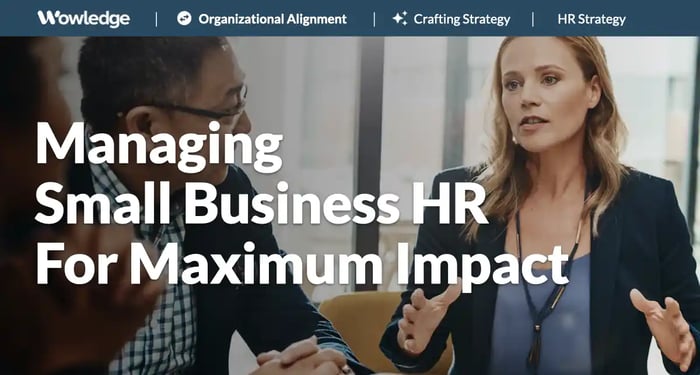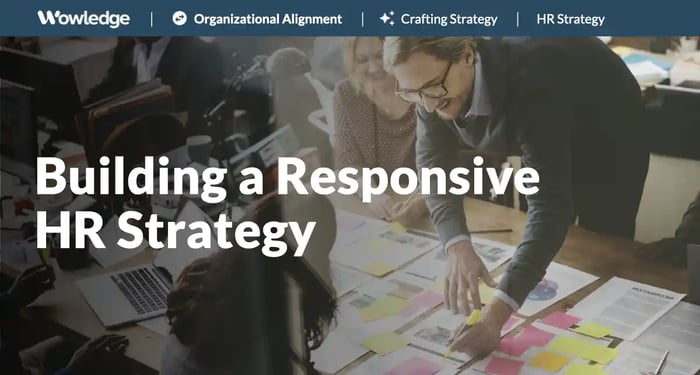Table of Contents
Effective HR management is a complex undertaking that requires a broad set of specialized skills and capabilities. Those complexities expand exponentially when performed in small businesses, which range from as few as 10 to as many as 500-1,000 employees. Despite the attention and press received by major, industry-leading employers about their HR and talent practices, most organizations are supported by small business HR teams who must work with fewer and often less sophisticated resources. However, those limitations do not mean great HR strategies, practices, and support cannot be provided.
Small businesses dominate the landscape
The US Chamber of Commerce estimates that 99.9% of US businesses (33.2 million) are small (fewer than 500 employees) and create 63% of new jobs. They employ 46% of the U.S. workforce and generate 43.5% of the nation’s gross domestic product (GDP).
These organizations face the same risks as larger employers, yet face unique resourcing challenges. Once an employer builds a staff of 25-50 or more employees, needs arise that require some level of HR management. Legal and regulatory risks related to personnel actions or decisions might run afoul of various wage and hour, employment discrimination, employee benefits, and health and safety laws and regulations, which can lead to lawsuits and charges. Those legislative requirements also involve formal and regular reporting to federal, state, and local government entities, led by the IRS and Department of Labor, as well as state labor and human/civil rights agencies.
Those create business risks that require skilled support, and they are only the first of many pressures on small business HR professionals and teams.
Challenges facing small businesses
Starting and sustaining a thriving business of any size and scale is rife with challenges, barriers, and potholes. The difference with small companies tends to be resource constraints, as revenue levels often do not support expenditure levels required for growth. Consider financing, such as access to credit and external funding. According to the US Chamber of Commerce, most small businesses rely upon personal savings (80%), credit cards (70%), local banks and credit unions (60%), and friends and family (40%). The reliance upon personal or family funds and expensive credit card debt can drain and stress personal financial well-being and relationships.
The second major issue is staying power, or the likelihood of longer-term success. It is estimated that 90% of start-up companies fail, and many businesses last only 5-10 years. Small business owners and partners often lack the required breadth of skills and expertise to operate a successful organization. Consider the reasons that Investopedia reports as primary reasons for failure and underperformance: poor budgeting and expense management, weak or nonexistent strategic planning, inability to obtain sustainable financing, inadequate and ineffective market and product or service targeting, partnership difficulties, and a lack of deep expertise. The actual production and delivery of products and services represent additional risk, as quality levels, customer satisfaction, and meeting production volumes in a timely and reliable manner are essential outcomes that can drive repeat purchases and expanded sales.
While the U.S. Census Bureau reports that 59% of small businesses have been operating for at least 6 years, the average time to achieve profitability ranges from two to five years. The pressures that those realities and issues place on business leaders and owners, as well as their willingness to continue operating the business, are immense.
A third key issue is the relative competitive recruitment and retention position of smaller companies, which are often less able to provide higher pay and richer benefits and market themselves as well as larger, better-known employers. Without the large, sophisticated, and technologically enabled employment branding and marketing capabilities, small business HR teams are handicapped to a certain extent. However, recent trends with GenZ college graduates offer hope with the findings that the last four graduating classes have increasingly applied to small employers, with 37% applying to companies with fewer than 250 employees, up from only 25% just three years prior. Furthermore, 33% prioritize finding a job near their family, and 32% near their hometowns. That is good news for small employers relying on a college hiring advantage from local and regional schools.
Small business HR teams face challenges directly related to the organization’s objectives, priorities, and challenges. HR priorities should always be directly linked to achieving or overcoming barriers to business objectives.

Decisions to make when managing small business HR
Regardless of the company's stage of maturity (e.g., start-up, emerging, growing) or the pace of growth and expansion, the same questions about what, how, and how fast to build an HR capability will naturally need to be addressed. It is crucial to understand what the business is prioritizing, what it can (and cannot) afford, and how HR, regardless of size and resourcing, can directly contribute to achieving those goals.
The linkage between business and HR objectives ties small business HR to larger and better-resourced teams. It can be argued that in smaller organizations, HR alignment to business goals is of even greater importance given their ability to focus on fewer lines of business and geographies. One thing that never changes is the need for HR teams (of all sizes) to support the company's primary aims directly and visibly. Decisions need to be made on some critical fronts.
Who handles HR?
The primary issue for HR in smaller organizations is the relative lack of resources. This relates first to who will be assigned responsibility for the HR function. This can mean that the CEO, President, or CFO manages the function in the smallest of organizations. The decision is based upon the required level of expertise, the complexity of services to be delivered, and the time needed to conduct and oversee the HR functionality that has been selected. As the company grows, meeting operational recruiting needs, employee policies, benefits, and pay levels often leads to hiring one or more HR professionals who can effectively drive and manage those capabilities. An alternative option, depending upon budget and affordability, is contracting for the services of a fractional leader in HR who can provide part-time, but recurring services as a strategist, process and policy definer, and experienced coach/mentor to the business leaders.
What services will HR provide?
The next question is to determine the business's needs so that HR products, processes, and services can be prioritized. The most typical are those most basic to delivering business processes and customer outcomes—payroll and benefits, recruiting, training (compliance, core operational and technical skills, customer sales and support). Furthermore, given restricted budgets, HR self-service resources are also often prioritized through the publication (online or printed) of employee handbooks, policy manuals, job descriptions, payroll and benefit plans, transaction templates, employment (hiring, discipline, merit pay) policies, and performance management process maps and tools.
What is the HR operating model?
An HR operating model defines how HR will be organized, clarifies how it will deliver various processes, products, and services, how (and where, when) technologies will be deployed, and who will be responsible for executing those. The traditional model of a CHRO leading multiple HR business partners (HRBPs), centralized centers of excellence (COEs), and shared (administrative and technology) services group is often too expensive and unwieldy for small business HR teams.
Instead, four (4) key options exist for delivering services and support to the business, which are often combined to meet individual organizational needs:
- Outsourced HR: the selective contracting out of essential, but administratively burdensome capabilities such as payroll, benefits administration, retirement & savings plans, recruiting, and training.
- Delegation to other internal functions: the shared or outright ceding of responsibility for specialized policies, practices, and programming to other internal functions with the necessary subject matter expertise. Common examples include sales training and compensation (to the Sales organization), technical training, eLearning, HR information systems and technologies (to IT), compensation and benefits, HR budgeting, and headcount planning (to Finance).
- Delegation to line managers: providing guidance and resources, but execution responsibilities to individual managers for employee selection and hiring, performance management, promotion decisions, employee discipline, and skill development recommendations.
- HR business partners and generalists: provide coaching and guidance to managers, handle employee relations issue escalations, and guide and approve the execution of HR policies and actions. Depending upon available budget and staffing, specialist support can be provided by a combination of internal HR and any of the resources above.
What will the internal HR leader and team be accountable for?
Regardless of the operating model decisions involving handing off selected HR responsibilities, some should remain with an HR internal leader and staff members who are uniquely qualified and experienced at handling those. All HR strategies (e.g., strategic HR plan, talent and talent management strategies, workforce planning, compensation and benefits) should remain as small business HR responsibilities, as are the governance of culture, employee listening, employee experience, process refinement, and HR technology selections and enhancements. The key is determining and adapting to changes in what the organization needs to drive business and customer success, and preparing its leaders, managers, and employees to execute against those.
One caution about outsourcing and delegating HR to other functions
There are risks in fully or over-delegating HR responsibilities to external or internal departments. A recent survey of small company employees without an HR function found that 50% felt the lack of an HR presence contributed to a toxic workplace. Furthermore, 64% reported that their direct supervisor had a hand in HR operations, with 24% saying they were uncomfortable with that arrangement. Perhaps most concerning was the finding that 43% did not feel they could confide in their HR, and over one-third did not trust them. This demonstrates the need for an independent, engaged HR function that retains its most crucial capabilities and responsibilities.

How a small business HR team can make the most significant impact
Specific strategies and steps have been shown to help small business HR teams maximize their value to the business and its leaders, managers, and employees. These are based upon the fundamental factors that drive HR success regardless of company size, scale, or maturity. The key is to start with those essential building blocks that create an environment where HR is a trusted and reliable partner, which consistently delivers on the basics (e.g., onboarding, payroll, benefits), and thus earns the right to be trusted with more sophisticated business-driving activities (e.g., executive coaching, strategic workforce planning, innovative process redesign).
1. Evolve through maturity-based capability delivery
By nature, small business HR teams are leaner and less resourced, so they must establish reliable, easily accessible, and usable administrative processes. The key is to follow a model that incrementally builds confidence in the HR function with these four, progressive steps:
- Avoid risk by effectively managing legal and regulatory risk and requirements.
- Install efficient and streamlined core HR and talent processes that address critical talent priorities (e.g., recruiting, compensation, talent development, performance management) and support employee performance, productivity, and capability growth.
- Develop HR and talent strategies and plans aligned with business objectives and operational priorities (e.g., leadership and management development, succession planning, mobility, and career development).
- Establish organization development and sustainability processes and practices that drive stakeholder, customer, and market value enhancement (e.g., culture building, employee and customer experience, community presence and support).
2. Establish and maintain a focus on the key drivers of business success
The most significant opportunity for small business HR leaders and teams is being closer to the business, strategy, and decision-making processes than peers in larger companies. Many mid-sized and large organization HR managers and HRBPs have to wait years until they have the chance to observe and then participate in the development of business direction. Taking advantage of this is a critical element of small business HR success. It calls for developing keen insights and understanding the drivers, levers, and barriers to success in any organization. Examples include:
- For-profits: sales, cost control, production methods, product and service quality, customer satisfaction.
- Non-profits: funding (sponsorships, grants, donations, membership fees, fundraising), overhead cost management, mission alignment.
The key is to “know the business you are in intimately.” This will create credibility as a voice of talent expertise, trust in the guidance and policy interpretation provided, and faith in proposed innovations or upgrades to established HR processes, practices, and programs.
3. Do the basics well
Small business HR teams and professionals must have well-executed core processes. Refining those over time to make them easier for employees and managers to accomplish and complete can reduce employee “pain points” and resistance to process compliance. Generate solid reporting from valid and reliable data inputs by designing easily understood and followed forms and systems to create valuable insights (e.g., payroll error reports, benefits enrollment confirmations, employee turnover). Develop practical and streamlined processes for completing new hire and compliance documentation, such as payroll and benefits registrations, work eligibility documents, employee badging, and system access enrollments.
Understand all legally required benefits, protections policies, procedures, and reporting (e.g., workers’ compensation, paid time off, disability insurance, OSHA, Civil rights act of 1964, ADEA, ADA, FMLA, FLSA, NLRA, and federal, state and local minimum wage laws) and monitor and execute against those fully.
4. Hire for multiple skills and entrepreneurial capabilities
Hiring employees in a small business is critical, given that fewer people design, develop, manufacture, and deliver the organization’s products and services. As a result, the quality, volume, and speed of their input and output disproportionately impact organizational success. In other words, hiring mistakes cost more, and great hires drive substantially more in smaller organizations.
Focus screening, selection, and hiring decisions on more than the technical or functional skills required for a job. Create success profiles of candidates with a demonstrated history of skills capabilities that differentiate performance in smaller organizations—self-starting, resourcefulness, integrative thinking, curiosity, continuous learning, adaptability, and agility. Seek candidates with an entrepreneurial mindset and behaviors, innovative tendencies, and a passion for creating new ways to accomplish their work and deliver the best to customers.
HR team members should be evaluated similarly, with the addition of proven capabilities in coaching, advisory, and interpersonal skills, depth in priority functional areas (such as recruiting and selection, training and instructional design), conflict management, and experience in start-up and small business HR organizations. Perhaps most critical are resourcefulness and knowledge of the business they are supporting.
5. Outsource intelligently
Consider HR or administrative outsourcing of administrative and compliance tasks such as payroll, benefits administration, compliance training, or recruiting. These can allow the small business HR team to supplement the existing staff with missing expertise (HR metrics and reporting, HR system implementation), free it up to focus on strategic coaching and support, and have extra help for high-volume activities (“Tier 1” employee relations support, annual benefits enrollment).
An additional benefit comes from some outsourcing providers, which include access to HR systems and apps, allowing the implementation of advanced HR technologies (HRIS, LMS, ATS) and avoiding purchase and maintenance costs and efforts. These organizations, referred to as HR outsourcing (HRO), administrative services organizations (ASO), and professional employee organization (PEO), charge on a per-employee, project-based, or retainer basis. However, they require oversight and issue escalation support.
6. Develop differentiating employee benefits and experiences
Competing with larger, better-resourced, and more prominent firms for talent does not require bigger budgets. As seen with recent college graduates who are increasingly drawn to smaller companies, there is a shifting of workers' preferences towards companies that provide better development opportunities, more autonomy in how they perform their jobs, greater exposure and access to experts and decision makers, more flexibility, and greater advancement. These are uniquely available in many smaller companies and should be used in job postings and internal employee communications. They should also be promoted widely in the job market.
Other approaches included understanding what employees want most from the company and what engages and retains them. Key elements include offering unique experiential development opportunities (rotations, project teams, job trials), hiring from within (promote, transfer), assessing and promoting great people managers who inspire, coach, and develop their workers. Create ownership opportunities with cash-value stock, options, warrants, profit sharing, and ESOP benefits. Monitor and manage the culture and managerial behaviors with upward feedback, and use employee listening approaches that drive real action. Highlight rewards and recognition programs, focusing on employee engagement and job meaningfulness.
7. Rely on and learn from outside HR experts
The small business HR team should promote and support a continuous learning mindset. Provide HR team members with access to leading practices, methodologies, tools, and insights. Rely upon outside HR experts and thought leaders from SHRM, ATD, WorldatWork, or the American Payroll Association. Use Wowledge for structured, implementation-ready guidance built specifically for lean HR teams. Leverage independent consultants and firms to guide and co-develop strategies, processes, practices, and programs while educating and upskilling the HR team.
8. Leverage new technologies
Use newer and more affordable technologies to support the rapid development and deployment of HR products and tools, such as generative AI (GenAI) to draft job descriptions and postings, employee handbooks, compensation structures, learning objectives, and plans. Automated pre-employment aptitude, skill, and capability assessments can make screening decisions more objective and efficient. The U.S. Chamber of Commerce reports that small businesses using HR software plan to spend between $1,000 and $10,000 annually on those, and they can make processing of job candidates, managing payroll and compensation, compliance, new hire onboarding, and performance evaluations simplified, standardized, and traceable.
Relevant Practices & Tools
Core HR Strategy Practices to Define a Foundational Direction for the HR Function. >
An HR Strategy sets business-based human resource (HR) tactics that will constitute a comprehensive multi-year approach to managing the HR function's structure, governance, programs, policies, and practices... more »
Evaluating and Selecting an HR Service Delivery Model that Optimizes Short and Longer-term Impact. >
Before determining how to structure an HR team, a set of considerations should be reviewed regarding the "operating or service delivery model" to be implemented... more »
Using Technology to Deliver Streamlined HR Services and Insights. >
HR Technology has advanced to a level where it is currently capable of offering scalable productivity gains in processing HR transactions, with emerging technologies capable of recognizing trends and recommending solutions to those issues... more »
Designing a Long-term Incentive Plan for Key Roles to Foster Desired Future Outcomes. >
Organizations have identified the many benefits of paying for performance while focusing their organizational structure on long-term success... more »
The Success Profile Tool: Specify the Background, Skills, and Capabilities Expected from Individuals in Key Roles. >
A template resembling a job description further detailed with the competencies and useful experiences that separate minimum job requirements from the attributes and experiences... more »
About Wowledge
Wowledge is the implementation-first platform designed for lean HR teams and consultants who need to design and scale strategic HR programs efficiently—without starting from scratch.
Our members gain access to continuously updated best practices, step-by-step guidance, expert-built tools, and customizable templates—all structured to accelerate the development and implementation of key HR programs.
Recognizing that every organization operates at different levels of sophistication, Wowledge’s scalable system of best practices follows a stage-based approach—Core, Advanced, and Emerging—ensuring HR professionals can implement solutions tailored to their organization’s unique needs and goals.
Your Shortcut to Amplifying HR Impact!
Get started for FREE! Learn more.










